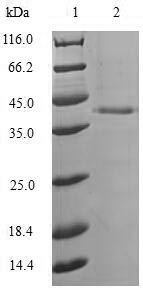The recombinant Aequorea victoria GFP protein is a fusion protein consists of the Aequorea victoria GFP protein (1-238aa) partnered with the N-terminal 6xHis-SUMO tag. It was produced in the E.coli. This recombinant GFP protein's purity is greater than 90% determined by SDS-PAGE. After electrophoresis, there is a 40 kDa protein band presented on the gel.
GFP is used as a biological marker. It is particularly useful due to its stability and the fact that its chromophore is formed in an autocatalytic cyclization that does not require a cofactor. This has enabled researchers to use GFP in living systems, and it has led to GFP's widespread use in cell dynamics and development studies. Furthermore, it appears that fusion of GFP to a protein does not alter the function or location of the protein. Green fluorescent protein has changed from a nearly unknown protein to a commonly used tool in molecular biology, medicine, and cell biology. The chromophore of GFP is critical for probing environmental influences on fluorescent protein behavior. Ever since the discovery of green fluorescent protein (GFP), FP-based genetically encoded Ca2+ indicators, which include the Förster resonance energy transfer (FRET) and GCaMP types, have been actively developed to achieve a large dynamic range, stokes shift, and long emission wavelengths.






